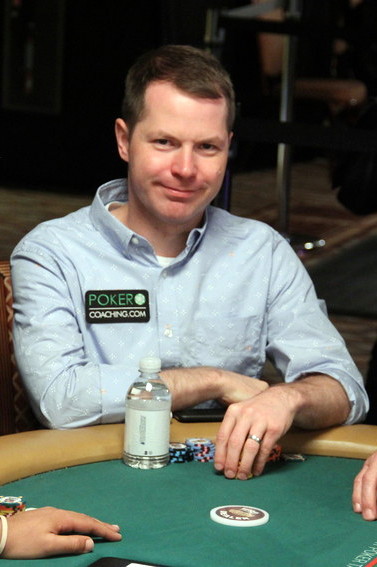






Poker Strategy With Jonathan Little: The Correct Way To Play An UnderpairDevelop Your Poker Skills And Learn How To Crush Games At PokerCoaching.com/CardPlayer |
|
|

Jonathan Little
One of my students recently told me about a hand from a live $2-$5 no-limit hold’em cash game that demonstrates exactly how you should play a marginal underpair.
A loose, splashy player raised to $15 out of his $500 effective stack from first position at a seven-handed table and our Hero with 10 10
10 elected to three-bet from second position to $45.
elected to three-bet from second position to $45.
While calling would normally be my default play because I do not want to get four-bet off my hand and there are lots of players yet to act, when facing a raise from a loose, splashy player, three-betting a strong linear range for value makes a lot of sense because you can expect him to call with numerous inferior hands, such as 8-8 and A 9
9 .
.
Against stronger players though, hands that are good, but non-premium, would usually be called, and you should three-bet with a more polarized range.
Everyone folded around to the initial raiser, who called. The flop came K 4
4 2
2 giving Hero a marginal underpair. The opponent checked.
giving Hero a marginal underpair. The opponent checked.
This is an excellent spot to either check or bet small. If Hero checks behind, he can easily call a turn bet and can usually call a river bet if he thinks his opponent will somewhat frequently bet the turn and river as a bluff.
Hero can also bet small in order to extract value from numerous worse marginal made hands such as 8-8, A 2
2 , and A
, and A 5
5 . Betting also protects against various over cards such as A-Q and Q-J that have a decent amount of equity.
. Betting also protects against various over cards such as A-Q and Q-J that have a decent amount of equity.
The main mistake many players make in this situation is to bet large, $80 or more, because then, they will usually only get called when they are in rough shape.
Hero bet $40 into the $95 and his opponent called.
While the $40 bet may seem exorbitantly small, it is perfectly fine. Do not feel as if you must make a bet that is at least as large as the bet on the previous betting round. The game is called “no-limit” for a reason. You can bet any amount, even a small one.
The turn was the 3 and the opponent checked.
and the opponent checked.
 am again fine with either checking or betting small, perhaps $50. I typically check in this spot, looking to call most river bets against loose, splashy players who will bet the river far too often.
am again fine with either checking or betting small, perhaps $50. I typically check in this spot, looking to call most river bets against loose, splashy players who will bet the river far too often.
Checking behind will ensure you do not get check-raised off your hand while ensuring you easily get to see the showdown.
Hero checked behind. The river was the 10 , giving Hero a set and completing the backdoor flush. The opponent bet $65 into the $175 pot.
, giving Hero a set and completing the backdoor flush. The opponent bet $65 into the $175 pot.
At this point, Hero has the effective nuts and should raise. If he was against a weak, passive opponent, his raise may only get called by flushes and straights, but given the opponent’s loose, splashy tendencies, it is safe to assume he will call a reasonably-sized raise with perhaps top pair and better made hands.
Hero raised to $180 and the opponent quickly called with 4 3
3 for turned two pair.
for turned two pair.
Even though the turned three will usually not be a terrible card for Hero’s 10-10, by checking behind, he ensures he will not lose a large pot with a marginal hand.
Many players instead bet the turn because they think they have the best hand. While they may have the best hand, when a lot more money goes into the pot, 10-10 will usually be crushed. So, check behind and be content to play a medium-sized pot with a medium-strength hand. ♠
 Jonathan Little is a two-time WPT champion with more than $7 million in live tournament earnings, best-selling author of 15 educational poker books, and 2019 GPI Poker Personality of the Year. If you want to increase your poker skills and learn to crush the games, check out his training site at PokerCoaching.com/cardplayer.
Jonathan Little is a two-time WPT champion with more than $7 million in live tournament earnings, best-selling author of 15 educational poker books, and 2019 GPI Poker Personality of the Year. If you want to increase your poker skills and learn to crush the games, check out his training site at PokerCoaching.com/cardplayer.
